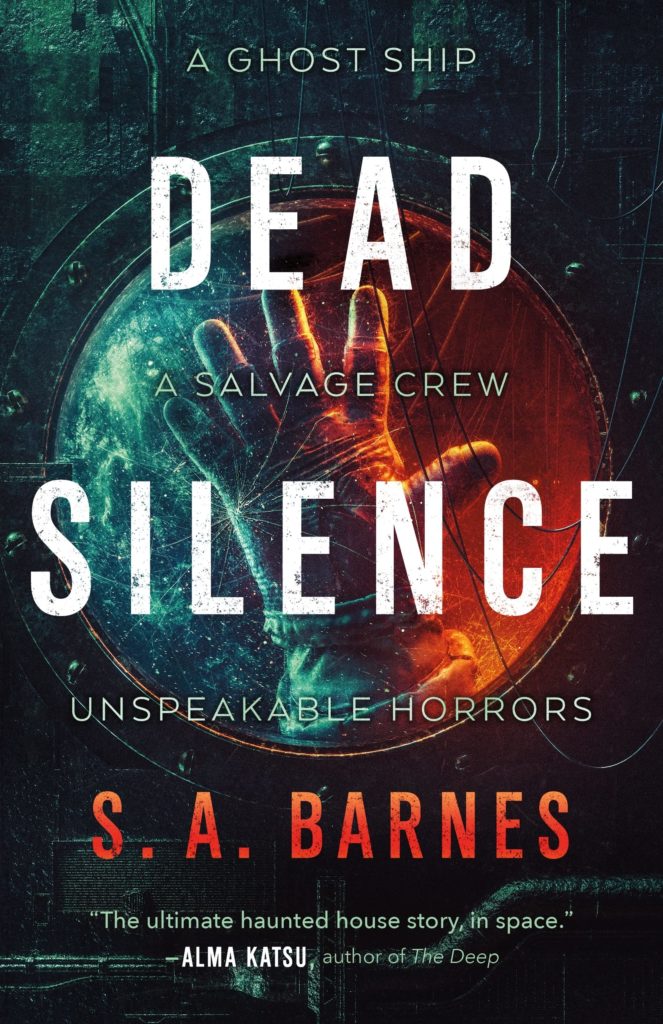Literary minds have been breaching the outer limits of space well before humans have even touched the stars, with some considering Johann Valentin Andreae’s The Chemical Wedding – first published in 1616 and thought to be written by the allegorical German aristocrat, Christian Rosenkreuz – as readers’ first foray into science fiction. In the over 400 years since, a lot of books, films and music – yes, space rock is a real genre – have exploded into our consciousness like a bat out of hyper-speed, so when new writing comes around that doesn’t just explore the untapped regions of space but liberally embraces the many moons of inspiration, I welcome it! Such is the case with author S. A. Barnes latest work of sci-fi horror, Dead Silence, in which the high school librarian turned genre maven taps into a bevy of both literary and cinematic fillips to bring you a nightmarish descent into the farthest reaches of space and sanity.
Chronicling the crew of a beacon-repair ship called LIN4 (or more humanly, LINA), led by Claire Kovalik – her trust and stability as broken as the transmitters they discover – and maintained by a rag-tag team straight out of Alien, Dead Silence quickly brings us to the ominous discovery of the Aurora; a 20 year old luxury space cruiser that was believed to have been lost to the cosmos. As Claire’s position amongst the stars nears obsolete – a desk job back at Earth with the largest corporation awaits – she and her crew (Kane, Lourdes, Voller and Nysus) decide to board the ship in search of answers and the possibility of fortune. What they discover is far from salvageable, and even further from sane.
Billed as TITANIC meets THE SHINING, Barnes goes further by employing the corporate corruption of ALIENS, the decayed discovery of GHOST SHIP, and the psychic rot of EVENT HORIZON, not just using these works as a stepping off point but as mirrors, reflecting a pretty sizeable veneration for the oft-maligned genre. She’s a fan who wears her references on her sleeve, never shying away from the clichés and tropes that suffuse so much of these works with palpable dread, even if readers know what horrors await. It’s less a fallibility and more of a necessity, as Barnes hopes no, expects, you to be well acquainted with these sources, taking readers and placing them within a world that feels as salvaged and scrapped together from parts as loose as those the repair crew maintains.
While they don’t always form a cohesive whole, often losing tension and terror amidst verbose monologues and scattershot pacing, there’s a fragmented feeling to the way Barnes unfolds events and employs specific moments of shadow-drenched fear, as if the formula of the genre isn’t meant to scintillate amongst scares but ruminate amongst very real, very human scars.
Claire, having been the lone survivor as a child in an outpost ravaged with disease and decay, carries these scars with her in the form of hallucinations and guilt, frailties that beg strength when vulnerability isn’t an option. She’s wounded from the start, mentally limping to keep up with a story that is uninspired as an over-used concept within the sci-fi/horror genre – exhausted team discovers macabre ship, team boards against better judgement, team slowly falls prey to someone or something. Yet against my desire for tighter pacing and scares, we’re treated to a character that’s achingly real, exposed amidst the vacuum of space who feels woefully relatable. Like Claire, many of us – also amidst disease in a constant flux of pandemic induced exhaustion – are just desperately trying to stay afloat in a world suffocated by darkness, and more often than not it’s in horror where hope most often prevails.
Don’t get me wrong, Dead Silence does find a way to burrow into your amygdala, its cacophony of pleas and sudden screams sharing an oxygen tank with the constant grisly displays of unmitigated madness. Barnes gleefully weaves together a tapestry of grim savagery that might not work on its own, yet it helps further exacerbate this urgent sense of distress, where horrid images end up acting like a lurking shadow to the crews disintegrating psychosis, generating a real sense of unease.
Except, the more I read and the further Barnes brought me into the unearthly tomb of the Aurora – the crew confronted by visions of loved ones (both living and dead) amid ghastly sights of the luxury liners rotting crew – the more I realized how much tenderness and pang there was beneath the putrefaction of human remains, feeling less and less a part of EVENT HORIZON and more an extension of SOLARIS, the 1961 novel about a research team beset by visions after investigating an alien planet. Where panic and perturbation leads way to a heart filled with yearning, but most importantly promise, as Claire fights through the pain of grief in order to save the one she loves and see a new dawn. While that might not win any horror accolades for the purists out there, it managed to fill this reader with hope and in these times that’s worth more than a dozen luxury liners.
Tags: Books, Film Reviews, Horror, Katie Klimowicz, Macmillan, S.A. Barnes, Sci-Fi, Space, Timo Noack, Tor Nightfire




No Comments